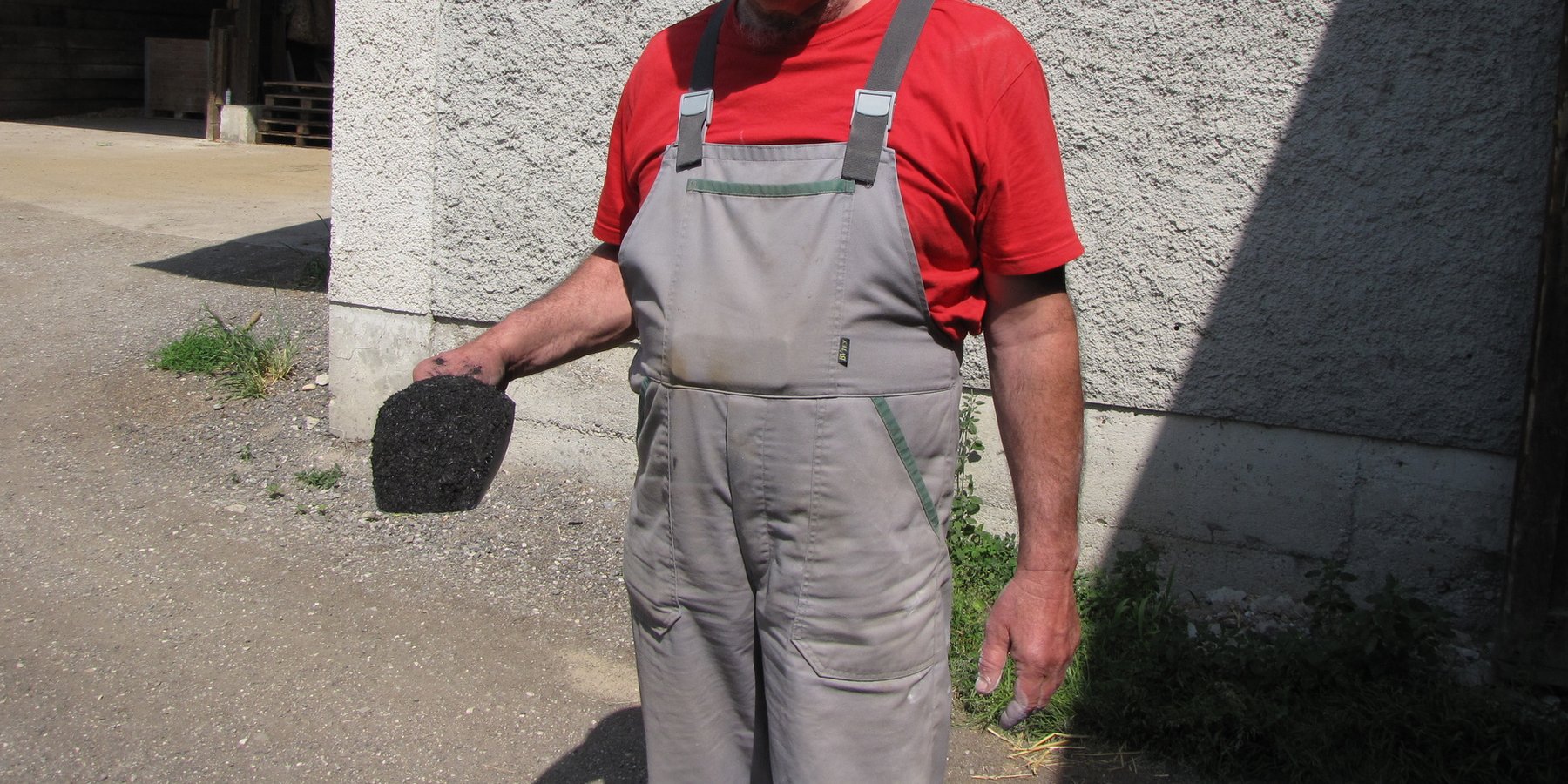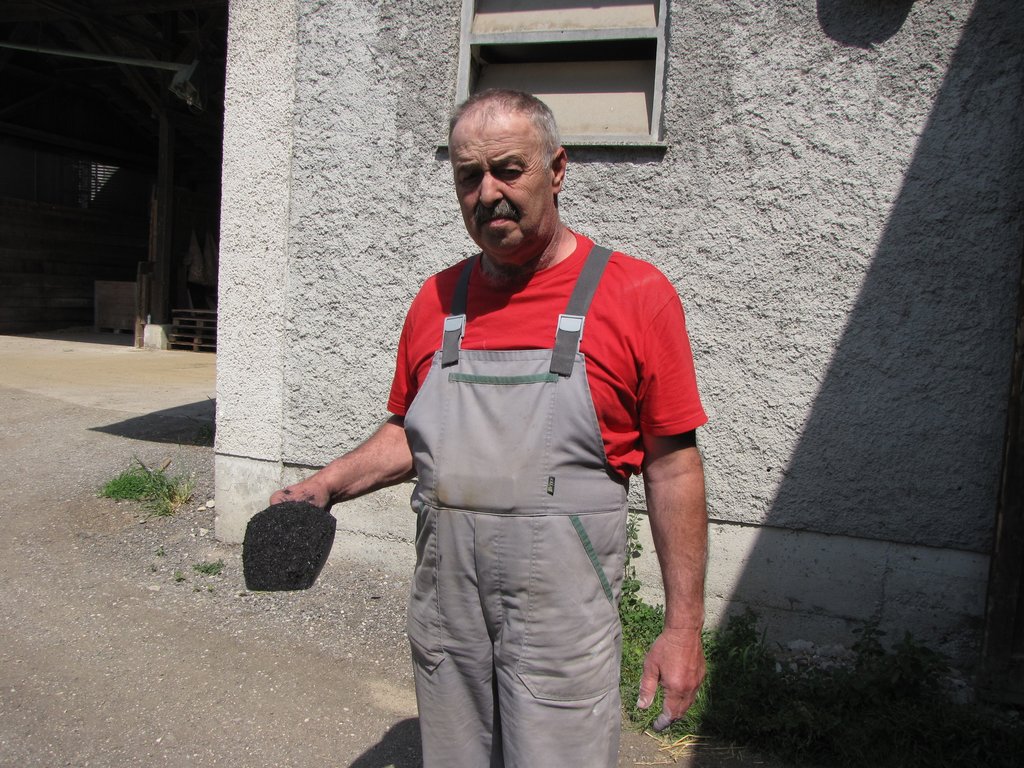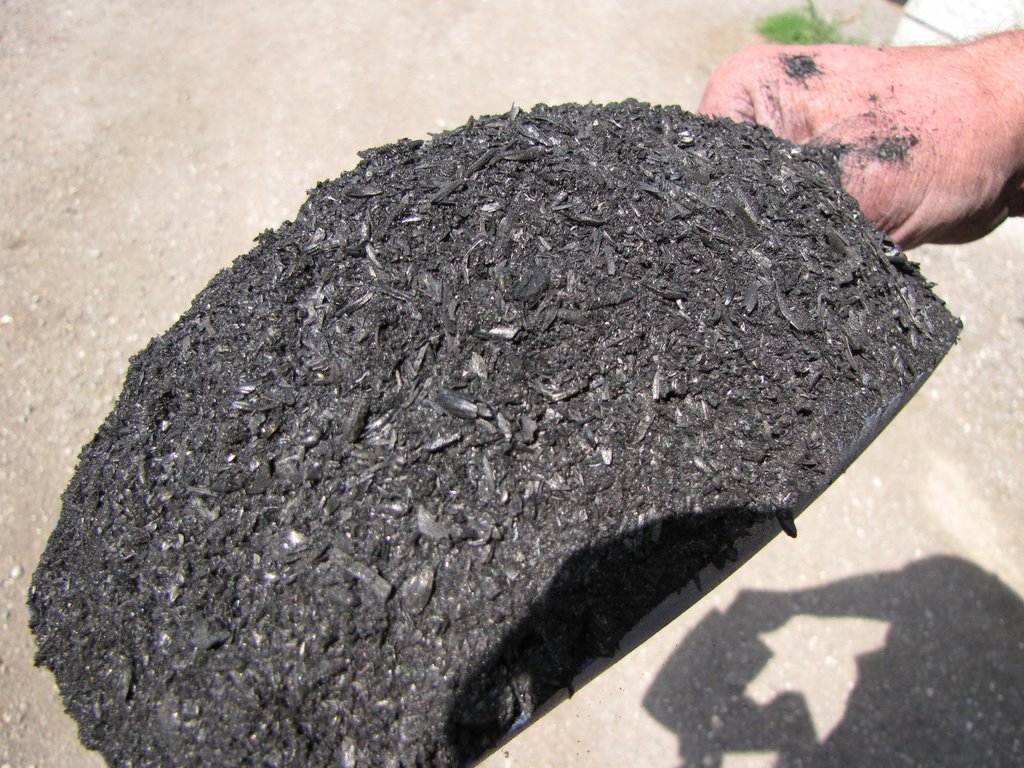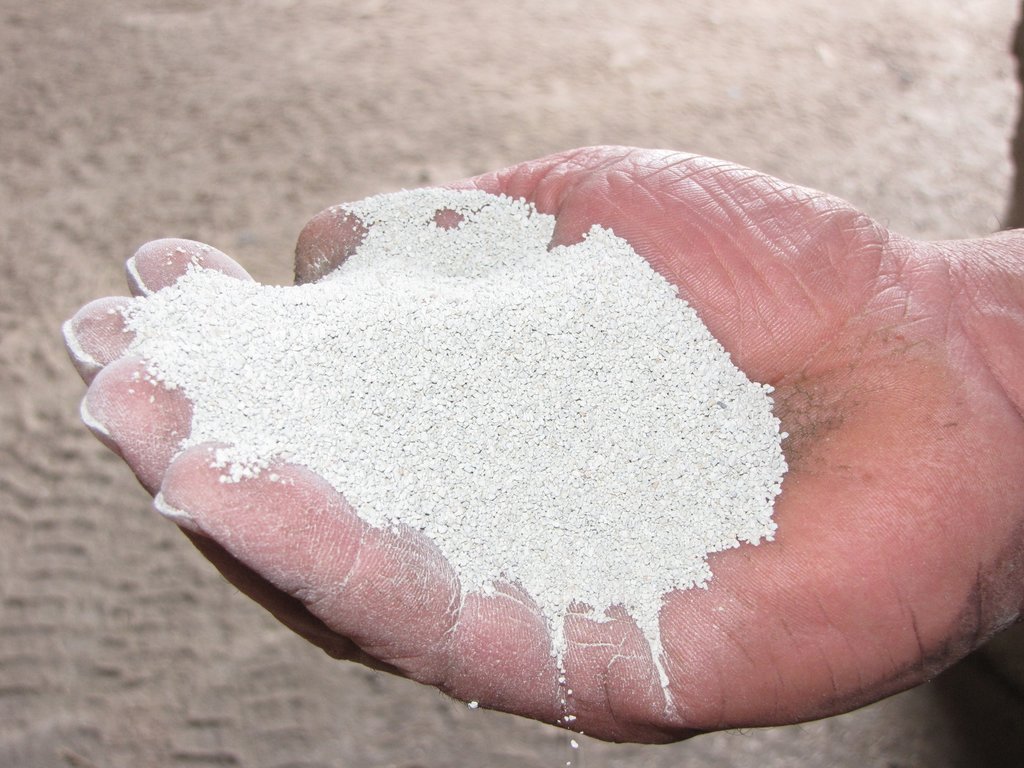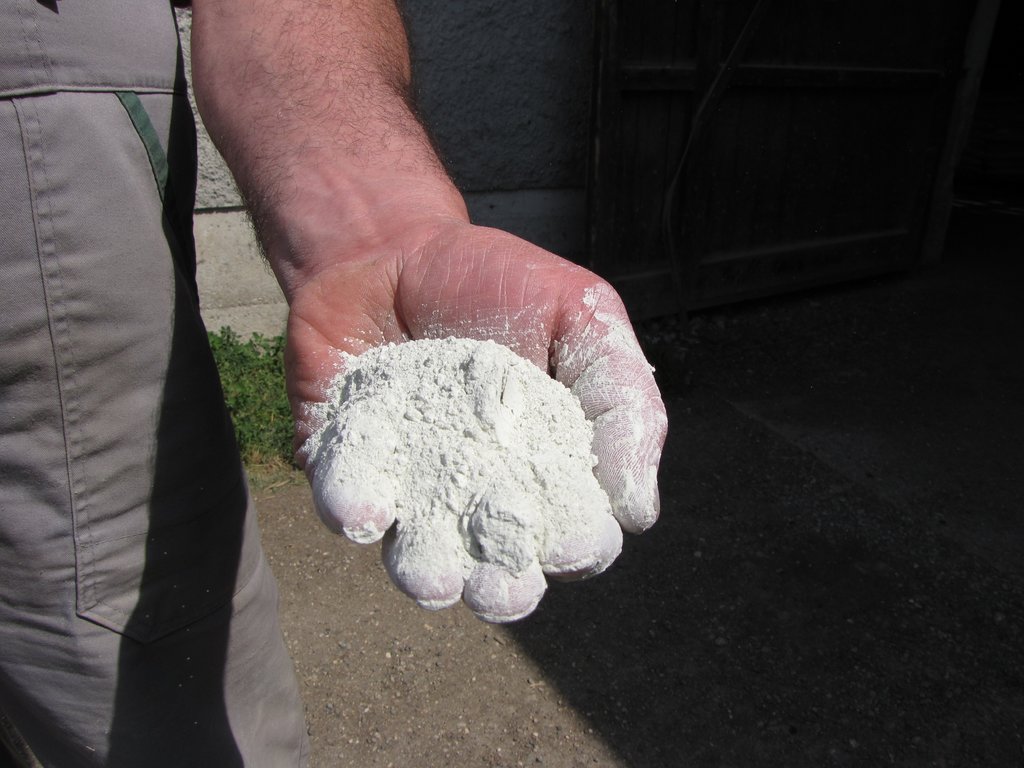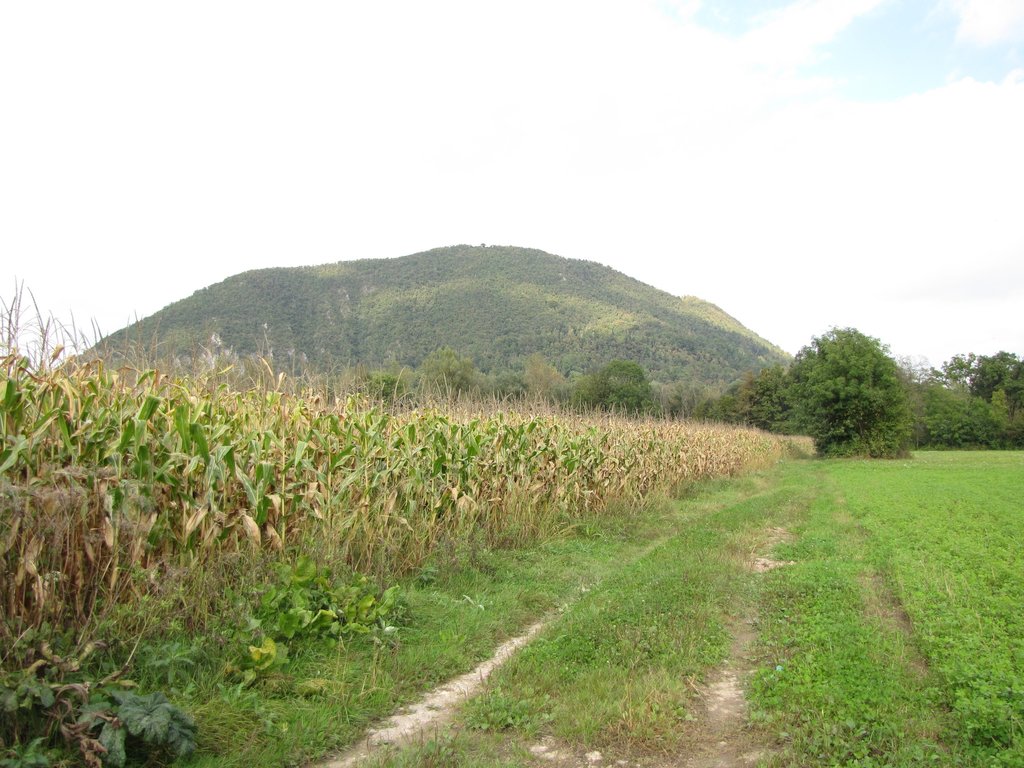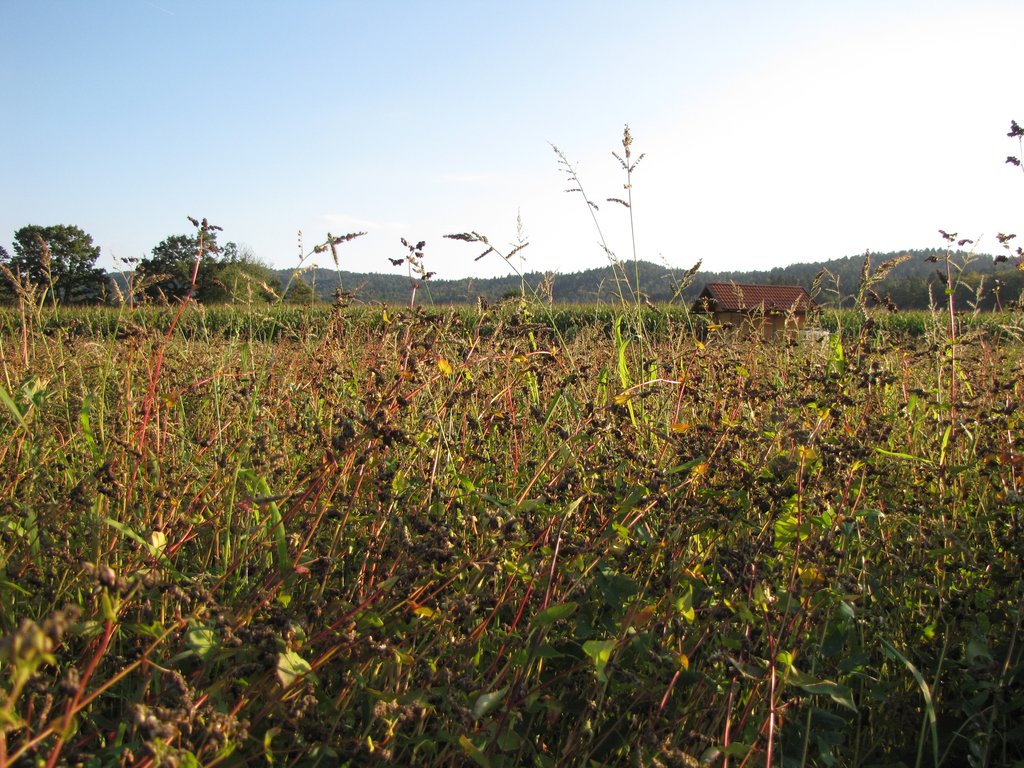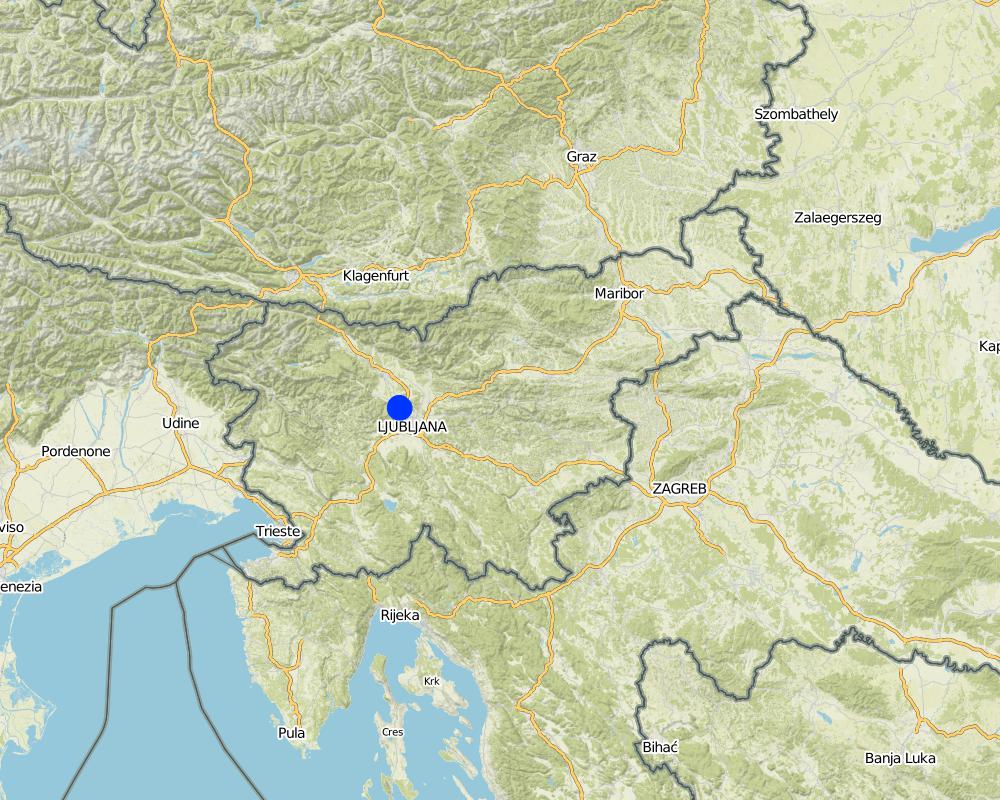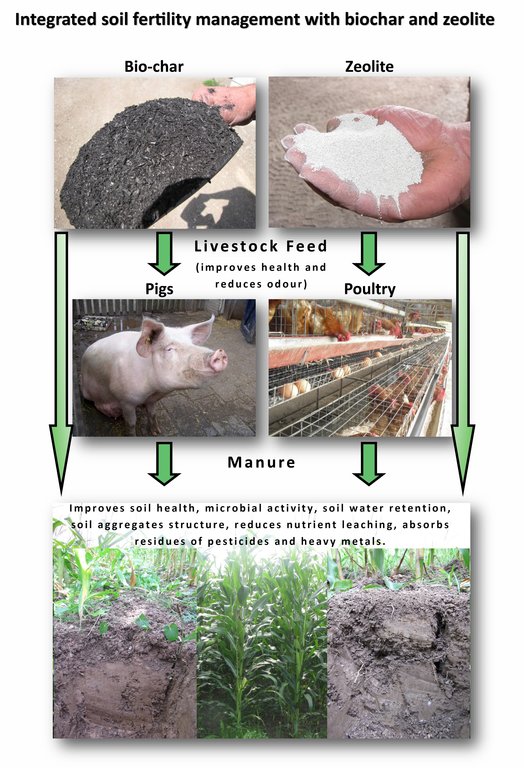Integrated soil fertility management with biochar and zeolite [Slovenia]
- Creation:
- Update:
- Compiler: Matjaz Glavan
- Editor: –
- Reviewers: Gudrun Schwilch, Ursula Gaemperli, Alexandra Gavilano
Integrirano gnojenje tal z bio ogljem in zeolitom
technologies_2785 - Slovenia
View sections
Expand all Collapse all1. General information
1.2 Contact details of resource persons and institutions involved in the assessment and documentation of the Technology
Name of project which facilitated the documentation/ evaluation of the Technology (if relevant)
Interactive Soil Quality assessment in Europe and China for Agricultural productivity and Environmental Resilience (EU-iSQAPER)Name of the institution(s) which facilitated the documentation/ evaluation of the Technology (if relevant)
Department for Agronomy, University of Ljubljana - Slovenia1.3 Conditions regarding the use of data documented through WOCAT
The compiler and key resource person(s) accept the conditions regarding the use of data documented through WOCAT:
Yes
1.4 Declaration on sustainability of the described Technology
Is the Technology described here problematic with regard to land degradation, so that it cannot be declared a sustainable land management technology?
No
2. Description of the SLM Technology
2.1 Short description of the Technology
Definition of the Technology:
Bio-char and zeolite are used in animal production and spread onto the fields as part of organic manure. Zeolite is also used as individual element in crop productions to improve soils. All residues are incorporated into the soil.
2.2 Detailed description of the Technology
Description:
1. Zeolite and bio-char are applied in arable fields. The technology is applied in flatland of Ljubljana with an average altitude of 350 m.a.s.l. The average annual precipitation is 1400 mm. The climate in the area is characterized by often stormy precipitation events and occasional droughts. Silty loam soils in the area are moderately deep to deep with medium soil organic matter. Area has good availability of surface water and groundwater of good drinking quality. The biodiversity in the region is medium and farmers practise basically a commercial agriculture with less than 10 percent of off-farm income. In general farm households are average in wealth and mainly mechanized/motorized. The size of the examined farm applying the technology is of medium scale with land partly owned by the land user and partly leased from the state. All farm households in the region have good access to good services and infrastructure.
2. Bio-char and zeolite as feed additive to pigs and chickens as part of a healthy diet. Animal excreta are spread over fields as part of organic manure (chicken - solid form and pigs - liquid form). Zeolite is spread also as individual element. All plant residues after harvest are left on the ground and incorporated during spring or fall by ploughing.
3. The purpose of technology is
(1) the improvement of the animal production efficiency,
(2) the absorption of nutrients for slower release,
(3) the absorption of toxic chemicals – lock,
(4) to retain more water in the soils,
(5) to prevent nutrients to be out-gassed from soil,
(6) to guarantee the vigour of soils - healthy microbial and fungi activity,
(7) and less unpleasant odours.
4. It is easy to establish and maintain the technology (see point 2. above) and produce multiple positive effects. Cost for establishment and maintenance are the same as no additional or special technology is needed. Main costs are related to buying the bio-char and zeolite. Cost related to feeding process are minor as bio-char and zeolite are added in to regular fodder mixture. Cost (working hours, fuel) can be more moderate when zeolite or bio-char is applied to fields as individual element.
5. Benefits are:
(1) the lower Nitrogen loss,
(2) the locking of toxic chemicals,
(3) healthy animals and plants going with better yields,
(4) and vital and healthier soils.
6a. Land users like:
(1) the avoiding of bad odours,
(2) and the small amount of work for visible results.
6b. Land users dislike the costs of bio-char and zeolite, which can be overcome by good market research.
2.3 Photos of the Technology
2.5 Country/ region/ locations where the Technology has been applied and which are covered by this assessment
Country:
Slovenia
Further specification of location:
Municipality of Ljubljana
Specify the spread of the Technology:
- evenly spread over an area
If precise area is not known, indicate approximate area covered:
- < 0.1 km2 (10 ha)
Map
×2.6 Date of implementation
Indicate year of implementation:
2015
If precise year is not known, indicate approximate date:
- less than 10 years ago (recently)
2.7 Introduction of the Technology
Specify how the Technology was introduced:
- through land users' innovation
3. Classification of the SLM Technology
3.1 Main purpose(s) of the Technology
- improve production
- protect a watershed/ downstream areas – in combination with other Technologies
- preserve/ improve biodiversity
- create beneficial economic impact
3.2 Current land use type(s) where the Technology is applied

Cropland
- Annual cropping
Annual cropping - Specify crops:
- cereals - barley
- cereals - maize
- cereals - other
- cereals - wheat (winter)
- legumes and pulses - peas
- buckwheat
Number of growing seasons per year:
- 1
Specify:
1 main crop (after cereals usually buckwheat)
Comments:
Main crops (cash and food crops): corn (grain) / cereals (winter wheat, winter barley) / buckwheat / peas
3.4 Water supply
Water supply for the land on which the Technology is applied:
- rainfed
3.5 SLM group to which the Technology belongs
- integrated crop-livestock management
- integrated soil fertility management
3.6 SLM measures comprising the Technology

agronomic measures
- A2: Organic matter/ soil fertility
3.7 Main types of land degradation addressed by the Technology

chemical soil deterioration
- Cn: fertility decline and reduced organic matter content (not caused by erosion)

physical soil deterioration
- Pk: slaking and crusting

biological degradation
- Bq: quantity/ biomass decline
- Bl: loss of soil life
3.8 Prevention, reduction, or restoration of land degradation
Specify the goal of the Technology with regard to land degradation:
- reduce land degradation
4. Technical specifications, implementation activities, inputs, and costs
4.1 Technical drawing of the Technology
Technical specifications (related to technical drawing):
The infographic shows the possible application of bio-char and zeolite and it positive impact on the soil. Both can be used as part of the feeding mixture or directly applied on the soil.
Author:
Matjaž Glavan
Date:
02/08/2017
4.2 General information regarding the calculation of inputs and costs
Specify how costs and inputs were calculated:
- per Technology area
Indicate size and area unit:
20 hectares
other/ national currency (specify):
EUR
If relevant, indicate exchange rate from USD to local currency (e.g. 1 USD = 79.9 Brazilian Real): 1 USD =:
0.89
Indicate average wage cost of hired labour per day:
50 EUR
4.3 Establishment activities
Comments:
No special establishment machinery is needed.
4.4 Costs and inputs needed for establishment
Comments:
No special establishment cost.
4.5 Maintenance/ recurrent activities
| Activity | Timing/ frequency | |
|---|---|---|
| 1. | mix bio-char and zeolite with fodder | all year around |
| 2. | spreading organic manure | spring to autumn |
| 3. | mulching residues | autumn |
| 4. | spreading zeolite | early spring |
| 5. | hire slurry tank | early spring |
4.6 Costs and inputs needed for maintenance/ recurrent activities (per year)
| Specify input | Unit | Quantity | Costs per Unit | Total costs per input | % of costs borne by land users | |
|---|---|---|---|---|---|---|
| Labour | Fodder preperation | person day | 10.0 | 50.0 | 500.0 | 100.0 |
| Labour | Spreading zeolite resp. manure | person day | 1.0 | 50.0 | 50.0 | 100.0 |
| Equipment | hire slurry tank (6 m3) | ha | 20.0 | 15.0 | 300.0 | 100.0 |
| Fertilizers and biocides | Bio-char for fodder | kg | 2000.0 | 0.4 | 800.0 | 100.0 |
| Fertilizers and biocides | Zeolite for fodder | kg | 1500.0 | 0.138 | 207.0 | 100.0 |
| Fertilizers and biocides | Zeolite at fields | kg | 3000.0 | 0.138 | 414.0 | 100.0 |
| Total costs for maintenance of the Technology | 2271.0 | |||||
| Total costs for maintenance of the Technology in USD | 2551.69 | |||||
4.7 Most important factors affecting the costs
Describe the most determinate factors affecting the costs:
price of bio-char and zeolite
5. Natural and human environment
5.1 Climate
Annual rainfall
- < 250 mm
- 251-500 mm
- 501-750 mm
- 751-1,000 mm
- 1,001-1,500 mm
- 1,501-2,000 mm
- 2,001-3,000 mm
- 3,001-4,000 mm
- > 4,000 mm
Specify average annual rainfall (if known), in mm:
1352.00
Specifications/ comments on rainfall:
average (1991-2000)
majority of rain in autumn, followed by summer, spring and winter
Indicate the name of the reference meteorological station considered:
Ljubljana Bežigrad
Agro-climatic zone
- sub-humid
strong summer thunder storms and showers - local precipitation occasional droughts
5.2 Topography
Slopes on average:
- flat (0-2%)
- gentle (3-5%)
- moderate (6-10%)
- rolling (11-15%)
- hilly (16-30%)
- steep (31-60%)
- very steep (>60%)
Landforms:
- plateau/plains
- ridges
- mountain slopes
- hill slopes
- footslopes
- valley floors
Altitudinal zone:
- 0-100 m a.s.l.
- 101-500 m a.s.l.
- 501-1,000 m a.s.l.
- 1,001-1,500 m a.s.l.
- 1,501-2,000 m a.s.l.
- 2,001-2,500 m a.s.l.
- 2,501-3,000 m a.s.l.
- 3,001-4,000 m a.s.l.
- > 4,000 m a.s.l.
Indicate if the Technology is specifically applied in:
- not relevant
5.3 Soils
Soil depth on average:
- very shallow (0-20 cm)
- shallow (21-50 cm)
- moderately deep (51-80 cm)
- deep (81-120 cm)
- very deep (> 120 cm)
Soil texture (topsoil):
- medium (loamy, silty)
Soil texture (> 20 cm below surface):
- medium (loamy, silty)
Topsoil organic matter:
- medium (1-3%)
5.4 Water availability and quality
Ground water table:
5-50 m
Availability of surface water:
good
Water quality (untreated):
good drinking water
Is water salinity a problem?
No
Is flooding of the area occurring?
No
5.5 Biodiversity
Species diversity:
- medium
Habitat diversity:
- medium
5.6 Characteristics of land users applying the Technology
Sedentary or nomadic:
- Sedentary
Market orientation of production system:
- commercial/ market
Off-farm income:
- less than 10% of all income
Relative level of wealth:
- average
Individuals or groups:
- individual/ household
Level of mechanization:
- mechanized/ motorized
Gender:
- men
Age of land users:
- middle-aged
5.7 Average area of land used by land users applying the Technology
- < 0.5 ha
- 0.5-1 ha
- 1-2 ha
- 2-5 ha
- 5-15 ha
- 15-50 ha
- 50-100 ha
- 100-500 ha
- 500-1,000 ha
- 1,000-10,000 ha
- > 10,000 ha
Is this considered small-, medium- or large-scale (referring to local context)?
- medium-scale
5.8 Land ownership, land use rights, and water use rights
Land ownership:
- state
- individual, titled
Land use rights:
- leased
- individual
Water use rights:
- individual
5.9 Access to services and infrastructure
health:
- poor
- moderate
- good
education:
- poor
- moderate
- good
technical assistance:
- poor
- moderate
- good
employment (e.g. off-farm):
- poor
- moderate
- good
markets:
- poor
- moderate
- good
energy:
- poor
- moderate
- good
roads and transport:
- poor
- moderate
- good
drinking water and sanitation:
- poor
- moderate
- good
financial services:
- poor
- moderate
- good
- poor
- moderate
- good
6. Impacts and concluding statements
6.1 On-site impacts the Technology has shown
Socio-economic impacts
Production
crop production
crop quality
animal production
risk of production failure
Comments/ specify:
Better soil moisture at periods of drought.
Water availability and quality
drinking water quality
Income and costs
expenses on agricultural inputs
farm income
Comments/ specify:
Small increase observed. However the technology was started two years ago and it is possible that increase could become bigger in the future.
Other socio-economic impacts
Bad odours on manure can be avoided due to the addition of bio-char and zeolite to the fodder.
Comments/ specify:
This was the main purposes of the technology. Along with that they discover other benefits.
Socio-cultural impacts
bad odours on manure can be avoided though the addition of zeloite and
Ecological impacts
Soil
soil moisture
Comments/ specify:
Farmer observed that soil moisture condition of the light sandy soils where zeolite was applied is better.
nutrient cycling/ recharge
Climate and disaster risk reduction
drought impacts
Comments/ specify:
Better soil moisture at times of drought.
6.2 Off-site impacts the Technology has shown
groundwater/ river pollution
6.3 Exposure and sensitivity of the Technology to gradual climate change and climate-related extremes/ disasters (as perceived by land users)
Gradual climate change
Gradual climate change
| Season | increase or decrease | How does the Technology cope with it? | |
|---|---|---|---|
| seasonal temperature | autumn | increase | very well |
Climate-related extremes (disasters)
Meteorological disasters
| How does the Technology cope with it? | |
|---|---|
| local rainstorm | not known |
| local thunderstorm | not known |
| local hailstorm | not known |
Climatological disasters
| How does the Technology cope with it? | |
|---|---|
| heatwave | not known |
| cold wave | not known |
| extreme winter conditions | not known |
| drought | well |
6.4 Cost-benefit analysis
How do the benefits compare with the establishment costs (from land users’ perspective)?
Short-term returns:
slightly positive
Long-term returns:
slightly positive
How do the benefits compare with the maintenance/ recurrent costs (from land users' perspective)?
Short-term returns:
slightly positive
Long-term returns:
slightly positive
6.5 Adoption of the Technology
- single cases/ experimental
Of all those who have adopted the Technology, how many did so spontaneously, i.e. without receiving any material incentives/ payments?
- 91-100%
6.6 Adaptation
Has the Technology been modified recently to adapt to changing conditions?
No
6.7 Strengths/ advantages/ opportunities of the Technology
| Strengths/ advantages/ opportunities in the land user’s view |
|---|
| Low costs, simple technology. Animal health. |
| Less unpleasant odours. Better crop growth. By fertilizing with slurry almost no clogging of pipes with slurry injection equipment for slurry tanker during incorporating it into the soil . |
| Better soil moisture means higher yield at drought. |
| Strengths/ advantages/ opportunities in the compiler’s or other key resource person’s view |
|---|
| Strength low labour requirements. Easy to handle and maintain the technology. |
| Low cost of materials. Positive impacts on soil moisture and fertilizers loss. |
| All materials (bio-char and zeolite) are natural and therefore possible to be applied in organic production as well. |
6.8 Weaknesses/ disadvantages/ risks of the Technology and ways of overcoming them
| Weaknesses/ disadvantages/ risks in the land user’s view | How can they be overcome? |
|---|---|
| Almost none. Maybe price and availability of materials. | Better research of bio-char and zeolite market. |
| Weaknesses/ disadvantages/ risks in the compiler’s or other key resource person’s view | How can they be overcome? |
|---|---|
| No significant weakness/disadvantages/risks to be mentioned |
7. References and links
7.1 Methods/ sources of information
- field visits, field surveys
1
- interviews with land users
1
When were the data compiled (in the field)?
29/05/2017
Links and modules
Expand all Collapse allLinks
No links
Modules
No modules


